Scottish Greenhouse Gas Emissions 2013
This publication provides estimates of greenhouse gas emissions in Scotland for the years 1990 to 2013.
This document is part of a collection
Section B. Results - Net Sources of Scottish Greenhouse Gas Emissions
2013 figures
Chart B1 presents the sources and sinks of Scottish Greenhouse Gas Emissions in 2013, grouped by Scottish Government sector.
Chart B1. Sources of Scottish Greenhouse Gas Emissions, 2013. Values in MtCO2e
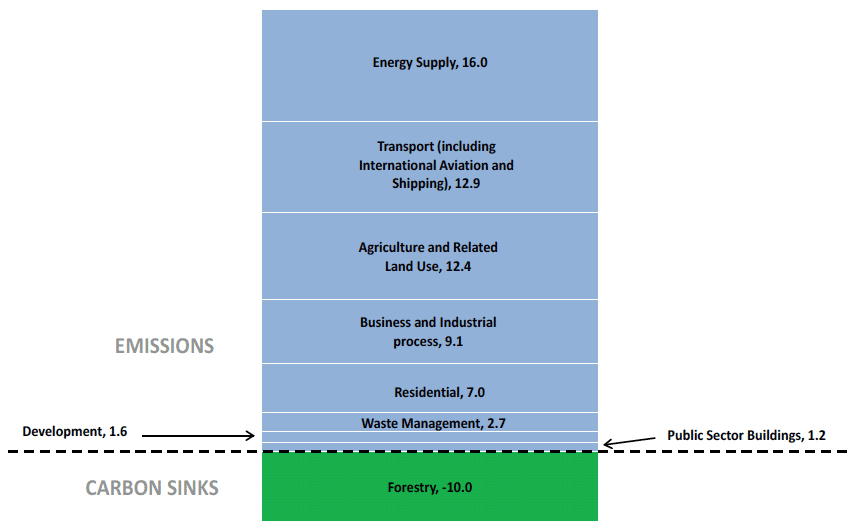
Main points
- In 2013, Energy supply was the largest source of net emissions (16.0 MtCO2e), followed by Transport (including International Aviation and Shipping) (12.9 MtCO2e and Agriculture and Related Land Use (12.4 MtCO2e). Emissions from the energy supply sector were greater than emissions from public sector buildings, development, waste management and residential sectors combined.
- Forestry was the only aggregate sector in which there has been a net emissions sink (-10.0 MtCO2e).
Table B1. Scottish Greenhouse Gas Emissions by Gas and by Scottish Government Source Sector, 2013. Values in MtCO2e
| TOTAL | Percentage share | Carbon dioxide | Methane | Nitrous oxide | Fluorinated gases | |
|---|---|---|---|---|---|---|
| TOTAL | 53.0 | 100.0% | 39.4 | 7.9 | 4.2 | 1.5 |
| Energy Supply | 16.0 | 30.2% | 15.4 | 0.5 | 0.1 | 0.0 |
| Transport (including International Aviation and Shipping) | 12.9 | 24.4% | 12.8 | 0.0 | 0.1 | 0.0 |
| Transport (excluding IA&S) | 10.5 | 19.9% | 10.4 | 0.0 | 0.1 | 0.0 |
| International Aviation and Shipping (IA&S) | 2.4 | 4.5% | 2.4 | 0.0 | 0.0 | 0.0 |
| Agriculture and related land use | 12.4 | 23.4% | 4.0 | 4.7 | 3.7 | 0.0 |
| Business and Industrial process | 9.1 | 17.2% | 7.7 | 0.0 | 0.1 | 1.3 |
| Residential | 7.0 | 13.2% | 6.7 | 0.1 | 0.0 | 0.2 |
| Waste Management | 2.7 | 5.1% | 0.0 | 2.6 | 0.1 | 0.0 |
| Development | 1.6 | 2.9% | 1.5 | 0.0 | 0.1 | 0.0 |
| Public Sector Buildings | 1.2 | 2.3% | 1.2 | 0.0 | 0.0 | 0.0 |
| Forestry | -10.0 | -18.9% | -10.0 | 0.0 | 0.0 | 0.0 |
Main points
Carbon dioxide was the main greenhouse gas emitted or removed in most sectors, with the exceptions of the Agriculture and Related Land Use and Waste Management sectors.
- Methane was the main net gas emitted in the Agriculture and Related Land Use sector (4.7 MtCO2e), followed by carbon dioxide (4.0 MtCOe) and nitrous oxide (3.7 MtCO2e).
- Almost all emissions in the Waste Management sector were emitted in the form of methane (2.6 MtCO2e)
Where F gases are emitted, they have been in relatively small amounts via the Business and Industrial Process source sector, as well as in the Residential sector.
Key Trends By Scottish Government Source Sector
Chart B2 presents the main sources of Scottish Greenhouse Gas Emissions in Scotland from 1990 to 2013, broken down by Scottish Government source sector. Note that for the purposes of presentation, some sectors have been grouped together on this chart. Chart B3 and Chart B4 specifically explore the trend in Energy Supply emissions. Chart B5 contains information on the absolute and percentage reductions in greenhouse gas emissions in every Scottish source sector over the entire time period, with Chart B6 containing the same information for the latest year.
Chart B2. Main Sources of Greenhouse Gas Emissions in Scotland, 1990 to 2013. Values in MtCO2e
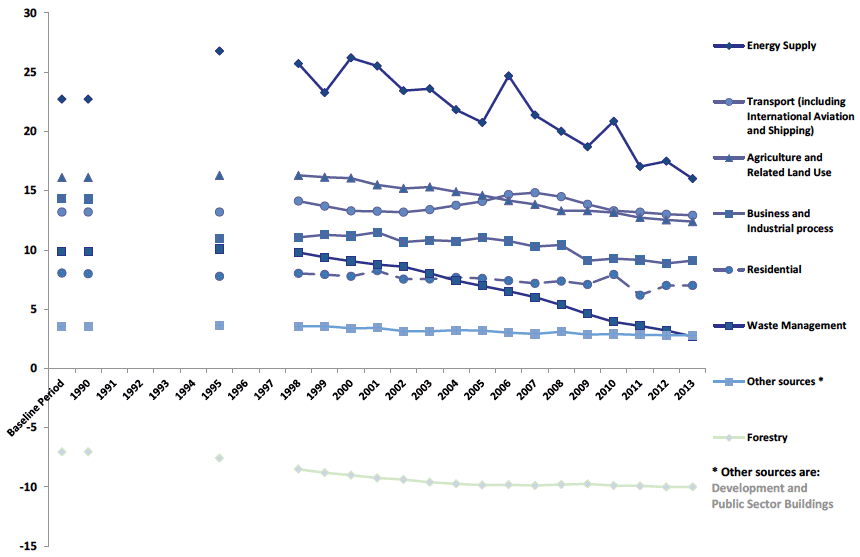
Main Points
Most sectors exhibit a general downward trend between 1990 and 2013, most clearly evident since 1998.
- In all years, energy supply is the main source of greenhouse gas emissions. The chart shows that energy supply is a very volatile sector, which is linked to the ambient temperature, particularly during the winter months; and fuel used for electricity production, which in turn is largely driven by the price of coal relative to "cleaner" fuels. Charts B3 and B4 demonstrate these effects in more detail.
- Much of the fall in emissions from the Business and Industrial Process sector has occurred between 1990 and 1995. This has been driven by a decline in emissions from manufacturing and the iron and steel industry over this time period.
- Net emissions from the agriculture and related land use sector have seen a gradual decline between 1998 and 2013, which can be linked to a decline in cattle and sheep numbers, as well as from the impact of historic changes in land use change to cropland and grassland.
- Emissions from transport (including international aviation and shipping) have seen a small overall reduction between 1990 and 2013. Emissions in this sector rose to a peak in 2007, before falling slightly. The recent falls in emissions have been as a result of a number of factors and has been largely caused by changes in emissions from cars. As well as reflecting improvements in car energy efficiency, road transport emissions have been affected by changes in the make-up of the passenger car fleet, with an increase in more fuel efficient diesel engines compared with petrol vehicles.
- Waste management emissions have fallen between 1998 and 2013. This is due to the progressive introduction of landfill gas being captured and used for energy. There could also be other factors which are contributing to this reduction such as improvements in the standards of landfill sites and changes to the types of waste going to landfill.
- The size of the net carbon sink from forestry has increased between 1990 to 2005, before remaining broadly constant in more recent years. This is partly because over the rate of afforestation has decreased over the last 40 years. In addition, conifer plantations, which were established in the mid-20th century, reached their planned rotation age and are now being felled and replanted - leading a fairly constant level of carbon sequestration in recent years.
Chart B3 shows that the generation of Scotland's electricity changes over time. Emissions from the electricity supply sector (such as power stations) are associated with these changes.
Chart B3. Generation of Electricity by Fuel, Scotland, 2004 to 2013. Percentage of Electricity Generated by Year

Data obtained from DECC Energy Trends, published December 2014[3]
Main Points
- There was a decrease between 2012 and 2013 in the percentage of gas being used for Scotland's electricity mix (from 11.2 per cent to 10.3 per cent). This continues the decline in the relative share of gas from 2006 onwards.
- There was also a decrease in the percentage of coal being used for the generation of electricity between 2012 and 2013 (from 23.6 per cent to 20.4 per cent). This is likely to be as result of the closure of a coal fired power station in 2013. Overall, there has been a relative decrease in the relative share of coal since 2006, although this series is volatile, with 29.5 per cent of Scottish electricity supply being fuelled by coal in 2010.
- The relative share of nuclear energy in Scotland's electricity supply is higher than other sources of energy at 34.9 per cent. This percentage share has increased from 2007, when nuclear energy represented 25.7 per cent of Scotland's electricity supply.
- The renewables sector (including hydro natural flow) has seen an overall increase from 11.7 per cent in 2004 to 32.0 per cent in 2013, and the rate of this increase has been greatest between 2010 and 2013.
Chart B4 shows the gas and coal prices for large users in the UK. The use of coal rather than gas in electricity generation can be sourced to these price effects in many cases.
Chart B4. Gas and Coal Prices for Large Users in the UK (2004 to 2013) - pence per kWh
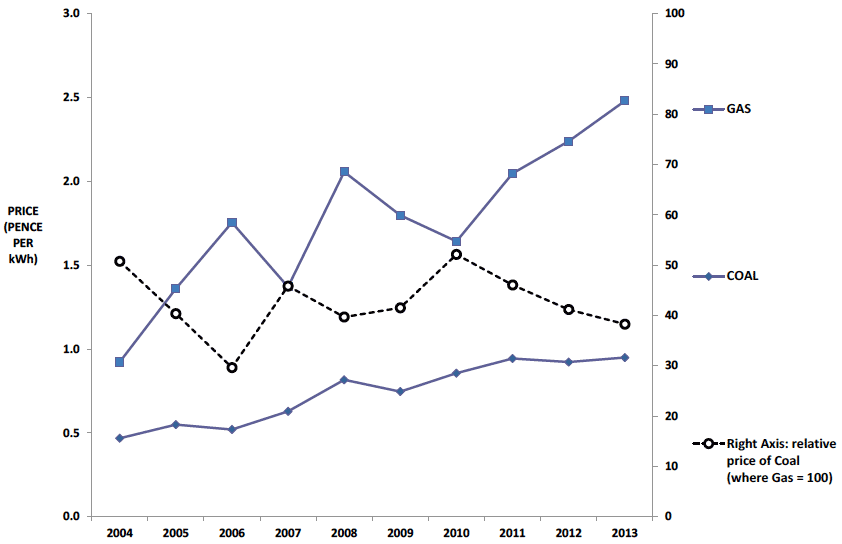
Data obtained from DECC: Digest of UK Energy Statistics[4]
Long term (1990 to 2013) and short term (2012 to 2013) trends by sector
Chart B5 shows how emissions have changed between 1990 and 2013 in all source sectors and chart B6 shows how emissions have changed between 2012 and 2013.
Chart B5. Change in Net Emissions by Scottish Government Sector Between 1990 and 2013 - in MtCO2e, and percentage changes[5]
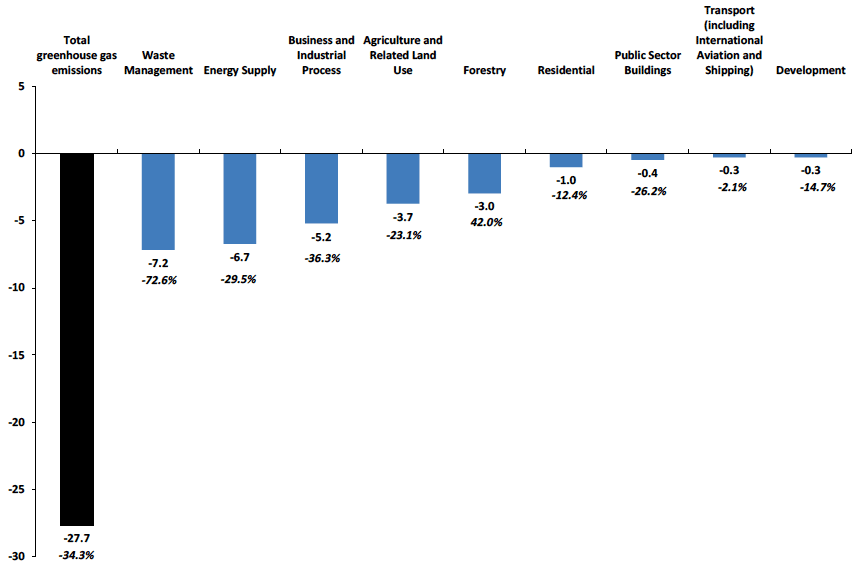
Chart B6. Change in Net Emissions by Scottish Government Sector between 2012 and 2013 - in MtCO2e, and percentage changes[6]
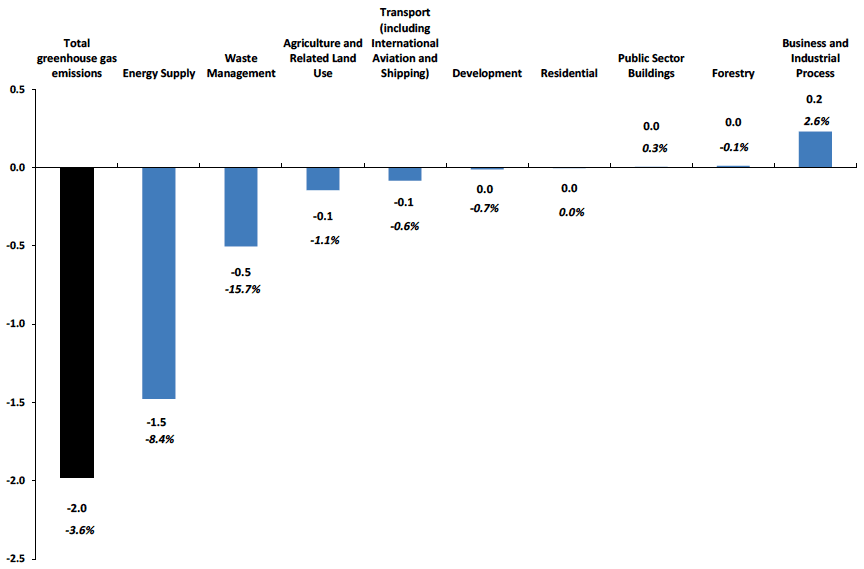
Total Emissions
Overall, there has been a 27.7 MtCO2e (34.3 per cent) decrease in net emissions between 1990 and 2013 and there has been a 2.0 MtCO2e (3.6 per cent) decrease in net emissions between 2012 and 2013.
Energy Supply
This sector has seen a 6.7 MtCO2e (29.5 per cent) fall in emissions between 1990 and 2013 - the second largest absolute fall of any sector. The Energy Supply sector saw the largest absolute decrease of any sector between 2012 and 2013 - a 1.5 MtCO2e (8.4 per cent) decrease. Charts B2 to B4 shows that this series is very volatile and this is largely driven by changes in the fuel mix for electricity production. The fall in energy supply emissions between 2012 and 2013 is likely to be as result of the closure of a coal fired power station in 2013. In addition to the fall in emissions from power stations, there has also been a much smaller fall in refinery emissions between 2012 and 2013, and a slight increase in emissions from flaring of oil.
Waste Management
This sector has seen a 7.2 MtCO2e (72.6 per cent) fall in emissions between 1990 and 2013 - the biggest absolute and percentage fall of any sector over this time period. This is due to the progressive introduction of landfill gas being captured and used for energy. There could also be other factors which contribute to this reduction, such as improvements in the standards of landfill and changes to the types of waste going to landfill. Between 2012 and 2013, the Waste Management sector saw a fall of 0.5 MtCO2e (15.7 per cent), which is the largest percentage decline of any sector over this time period.
Business and Industrial Process
This sector has seen a 5.2 MtCO2e (36.3 per cent) fall in emissions between 1990 and 2013. As shown in Chart B2, much of this decrease occurred between 1990 and 1995 - linked to a decline in emissions from manufacturing and the iron and steel industry over this time period. There has been a further smaller decrease between 2008 and 2009, coinciding with the recession, with figures being more level in recent years. There was a small net increase (0.2 MtCO2e; 2.6 per cent) in emissions in this sector between 2012 and 2013. There have been small fluctuations in emissions from this sector since 2009. The increase in emissions in the latest year appears to be caused by increases in emissions from gas combustion in private businesses and from combustion in the chemicals and food and drinks industries.
Agriculture and Related Land Use
This sector has seen a 3.7 MtCO2e (23.1 per cent) fall in net emissions between 1990 and 2013. This has been driven by a fall in emissions of carbon dioxide (Chart B9), methane (Chart B10) and nitrous oxide (Chart B11).
The fall in carbon dioxide emissions from the agriculture and related land use sector has partly been due to the effects of historic land use changes. For instance, there have been changes in the area of land being converted from other uses to cropland. Between 1990 to 2013, the rate at which land has been converted to cropland has fallen, with more land now remaining as cropland. The process of land being converted to cropland releases carbon dioxide; over time, this process gradually emits less carbon dioxide.
Methane emissions from agriculture have fallen from 1990 to 2013 due to a decline in cattle and sheep numbers - with a corresponding fall in emissions from enteric fermentation and animal wastes. Nitrous oxide emissions have also fallen due to improvements in practices on agricultural soils and a decline in livestock numbers.
Between 2012 and 2013, there was a 0.1 MtCO2e (1.1 per cent) decrease in net emissions of overall greenhouse gases from this sector. This has been due to a continued reduction in emissions from land being converted to cropland and an increase in the net greenhouse gas sink from grasslands. There has been a slight increase in emissions from agricultural soils in the latest year - despite a general downward trend over time. This is due to increased use of nitrogenous fertilisers.
Forestry
This sector has seen a 3.0 MtCO2e (42.0 per cent) increase in its carbon sink between 1990 and 2013. The majority of the sink arises from the large area of conifer plantations in Scotland, which is subject to forest management such as thinning and harvesting. The increase in the carbon sink has been because of an increase in the area of forest land over this time period, although the area of land being converted to forest from other land uses has been decreasing over time.
The carbon sequestration from forestry increased between 1990 and 2005. However, over the last 40 years the rate of afforestation has decreased. Combined with conifer plantations established in the mid-20th century reaching their planned rotation age now being felled and replanted, this has resulted in the size of this annual sink remaining relatively constant in recent years. Between 2012 and 2013, there was very little change in the size of the carbon sink from forestry.
Transport (Including International Aviation and Shipping)
Between 1990 and 2013, emissions from transport (including international aviation and shipping) fell slightly. Chart B2 shows that emissions rose to a peak in 2007, before falling slightly. This slight fall in recent years has been largely caused by changes in road transport emissions. As well as reflecting improvements in car energy efficiency, road transport emissions have been affected by changes in the make-up of the passenger car fleet, with an increase in more fuel efficient diesel engines compared with petrol vehicles. Up to 2007, there was a large increase in car vehicle kilometres travelled. Since 2007, there has been a small drop (around 2 per cent) in car vehicle kilometres travelled, although there has been a very slight increase in the years since 2011[7].
Breaking transport emissions down further, between 1990 and 2013, there was a 1.0 per cent decrease in transport emissions (excluding international aviation and shipping) and a 6.4 per cent decrease in emissions from international aviation and shipping. International aviation emissions have more than doubled between 1990 and 2013 (from 0.5 MtCO2e to 1.1 MtCO2e). This reflects the growth in aviation and the increase in international routes at airports. Emissions from international shipping have fallen by 36.9 per cent between 1990 and 2013 (from 2.0 MtCO2e to 1.3 MtCO2e). This is primarily due to a decrease in Scotland's port freight movements.
In the latest year, there was a 0.1 MtCO2e decrease in emissions from transport (excluding international aviation and shipping). There has been a slight decrease in emissions from cars between 2012 and 2013. This decrease has been partly offset by an increase in emissions from light goods vehicles and to a lesser extent, heavy goods vehicles.
There was a 3.9 per cent increase in emissions from international aviation and a 2.8 per cent decrease in international shipping between 2012 and 2013. It should be noted that the data series for international shipping is particularly volatile.
Residential
This sector has seen a 1.0 MtCO2e (12.4 per cent) fall in emissions between 1990 and 2013. Between 2012 and 2013, there was little change in emissions in this sector. Residential emissions are partly generated by space-heating homes and thus are related to external temperatures. Mean annual temperatures in 2013 were 0.2°C higher than in 2012[8]. Chart B7 shows that the summer and early autumn of 2013 was warmer than the equivalent period in 2012. However, the period from January to March 2013 was comparatively colder than the same period in 2012. As a result of this relationship to external temperatures, residential emissions can exhibit some large annual fluctuations.
Chart B7. Mean air temperature by month, Scotland. 2012 and 2013. Values in °C
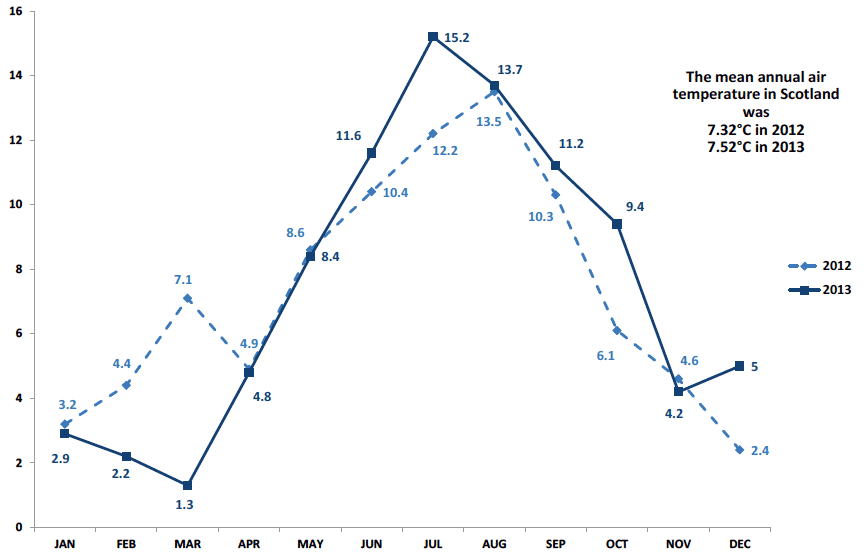
Data obtained from Met Office, May 2015[9]
Public Sector Buildings
This sector contributes a small proportion of Scotland's net greenhouse gas emissions. The main source of emissions from this sector is the use of natural gas for heating public buildings. There was a 0.4 MtCO2e (26.2 per cent) fall in emissions from public sector buildings between 1990 and 2013. This has been largely driven by a reduction in the use of oil and coal. Between 2012 and 2013, there was little change in emissions from this sector.
Development Emissions
This sector contributes to a small proportion of Scotland's net greenhouse gas emissions. There was a 0.3 MtCO2e (14.7 per cent) decrease in development emissions between 1990 and 2013. Between 2012 and 2013, there was very little change in emissions from this sector.
Emissions by type of gas
Chart B8 shows the trends in emissions, broken down by gas from 1990 to 2013.
Chart B8. Scottish Greenhouse Gas Emissions, by Gas, 1990-2013. Values in MtCO2e
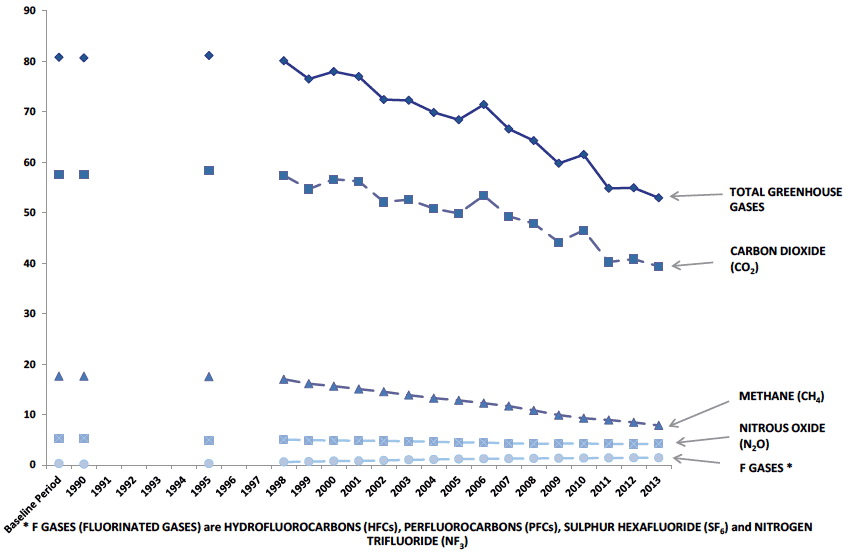
Main Points
- Carbon dioxide is by far the largest contributor of Scottish greenhouse gas emissions in all years (74.4 per cent of all emissions in 2013) and is the most volatile series of all gases - largely driven by changes in energy supply emissions and to a lesser extent, emissions from the residential and business and industrial process sectors.
- Methane in the second most common greenhouse gas in 2013 (14.9 per cent of all net emissions) followed by nitrous oxide (8.0 per cent) and F-gases making up the remainder (2.8 per cent).
- Methane has seen the largest percentage reduction from 1990 to 2013 (55.4 per cent), which have been largely driven by a reduction in waste management emissions. There have also been percentage reductions for both carbon dioxide (31.5 per cent) and nitrous oxide (20.7 per cent). Emissions from fluorinated gases have shown a 6-fold increase from 1990 to 2013 and this increase is driven by the introduction of hydrofluourocarbons (HFCs) from 1995 onwards. These HFCs replace chlorofluorocarbons (CFCs) which were banned by the Montreal Protocol due to their impact on the ozone layer.
Charts B9 to B12 present results on individual gases broken down by main Scottish government sector over time. Table B3 contains figures on all greenhouse gas emissions across the time series. Chart B9 shows how carbon dioxide emissions have changed from 1990 to 2013.
Carbon Dioxide (CO2)
Chart B9. Carbon Dioxide (CO2) Emissions by Scottish Government Sector, 1990 to 2013. Values in MtCO2e
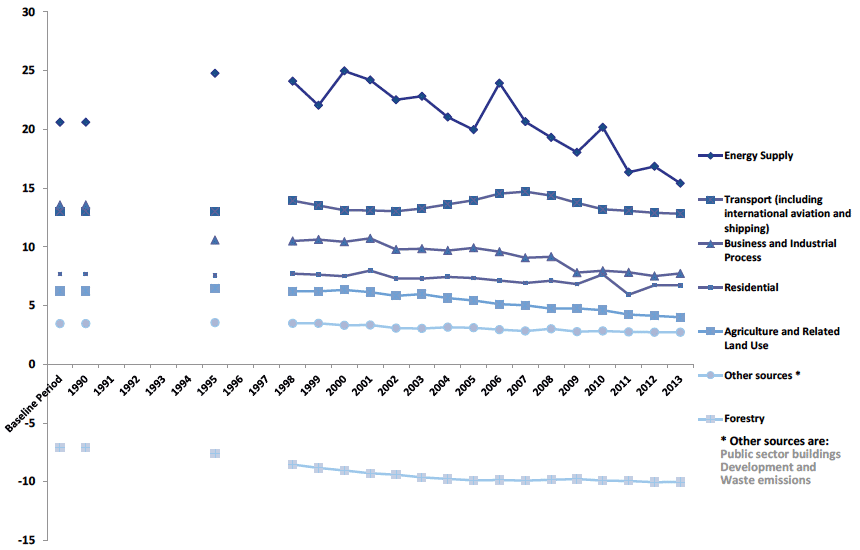
Main Points
- Chart B9 shows that energy supply is the key source of carbon dioxide emissions in all years between 1990 and 2013. Transport (including international aviation and shipping) is the next most common source of carbon dioxide emission in all years apart from 1990.
- Much of the decrease in carbon dioxide emissions between 1990 and 2013 has been driven by overall falls in the energy supply sector across the time period and in business and industrial processes between 1990 and 1995. Carbon dioxide emissions from the energy supply sector have been quite volatile over the time period, with the highest emissions occurring between 1995 and 2003, and a spike in 2006, related to a greater use of coal in that year.
- The agriculture and related land use sector has also seen a fall in net emissions in carbon dioxide - largely due to changes in land uses
- Forestry has been a net sink of carbon dioxide consistently between 1990 and 2013.
Methane (CH4)
Chart B10. Methane (CH4) Emissions by Scottish Government Sector, 1990 to 2013. Values in MtCO2e
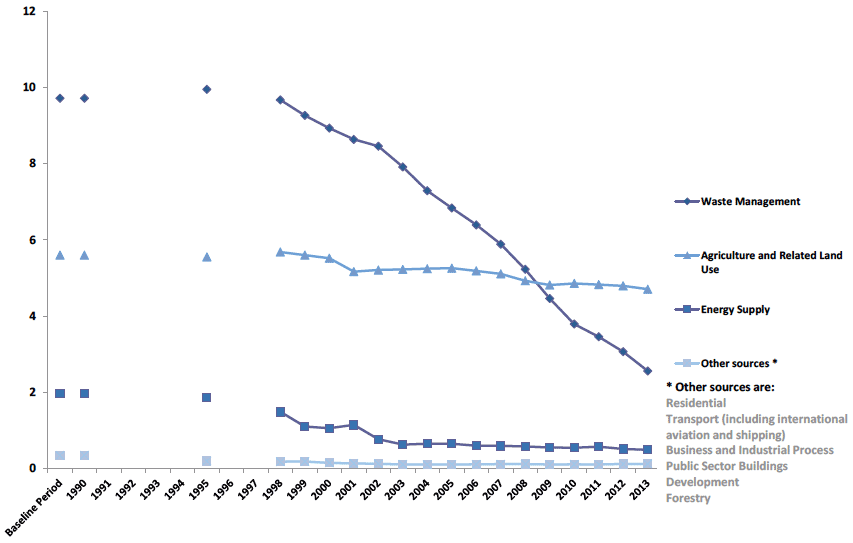
Main Points
- Methane emissions from waste management have fallen from 9.7 MtCO2e in 1990 to 2.6 MtCO2e in 2013 (a 73.7 per cent reduction). This is due to the progressive introduction of landfill gas being captured and used for energy. There could also be other factors which contribute to this reduction, such as improvements in the standards of landfill and changes to the types of waste going to landfill.
- Methane emissions in the agriculture and related land use sector have fallen from 5.6 MtCO2e in 1990 to 4.7 MtCO2e in 2013 - a 16.0 per cent fall over this time period. This reduction is partly linked to a fall in livestock.
- In the Energy Supply sector, methane emissions have fallen from 2.0 MtCO2e in 1990 to 0.5 MtCO2e in 2013, largely due to reductions in emissions from sources such as coal mining.
Nitrous Oxide (N2O)
Chart B11. Nitrous Oxide (N2O) Emissions by Scottish Government Sector, 1990 to 2013. Values in MtCO2e
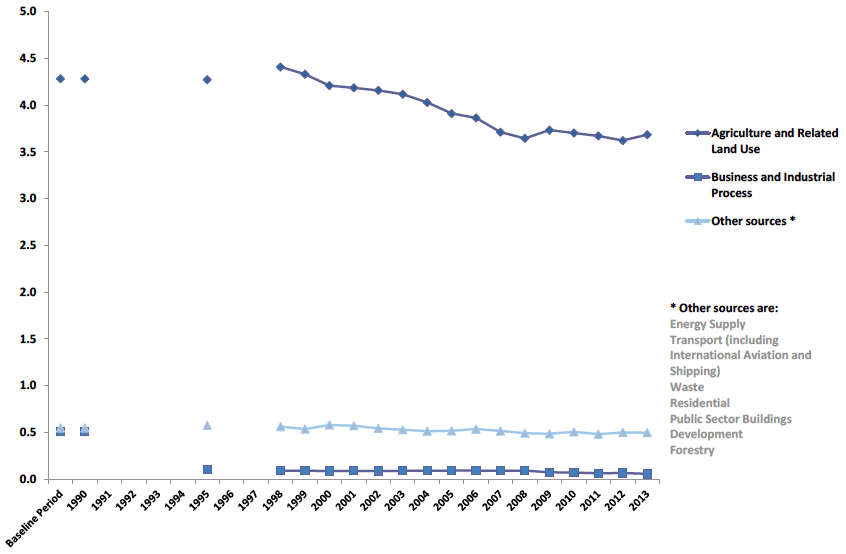
Main Points
- Agriculture and related land use is by far the main contributor to emissions of nitrous oxide. These are largely produced by agricultural practices on soils, and to a lesser extent animal manures. Emissions of nitrous oxide in this sector have fallen from 4.3 MtCO2e in 1990 to 3.7 MtCO2e in 2013. This has been due to improvements in practices in agricultural soils and there has also been a decline in livestock numbers. There has been a slight increase in emissions from agricultural soils in the latest year. This is due to increased use of nitrogenous fertilisers.
- Emissions of nitrous oxide in the business and industrial process sector have fallen from 0.5 MtCO2e in 1990 to 0.1 MtCO2e in 2013.
Fluorinated gases (F-gases)
Chart B12. F-gas Emissions by Scottish Government Sector, 1990 to 2013. Values in MtCO2e
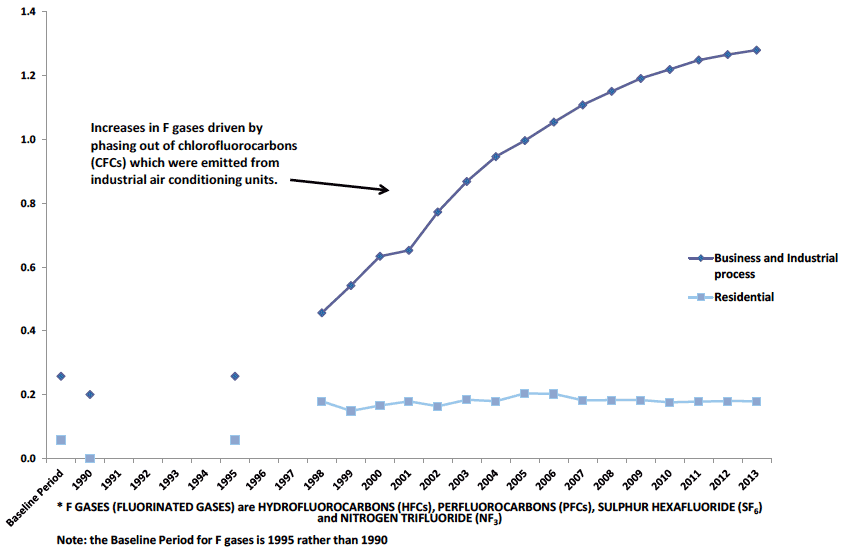
Main Points
- F gas are the most potent greenhouse gases with high global warming potentials but they are emitted in very small quantities. As a result, they contribute less to global warming than the other greenhouse gases in Scotland. Nitrogen trifluoride was added to the basket of greenhouse gases for the 1990-2013 inventory - it represents a very small source of greenhouse gas emissions across the time series (0.0 MtCO2e in all years)
- There has been a sharp increase in F gas emissions from business and industrial processes from 1990 and 2013 (from 0.2 MtCO2e in 1990 to 1.3 MtCO2e in 2013), although the year-on-year rate of increase is slowing in recent years. This is because F gases were introduced to replace chlorofluorocarbons (CFCs), which were used in appliances such as industrial air conditioning units. CFCs were banned under the Montreal Protocol, as they were contributing to the depletion of the ozone layer.
F gas emissions in the residential sector are caused by the use of aerosols and asthma inhalers, and represent between 0.16 and 0.20 MtCO2e between in the years between 1998 and 2013.
Table B2. Greenhouse Gas Emissions in Scotland by source sector: 1990 to 2013. Values in MtCO2e
| Source Sector | Baseline Period | 1990 | 1995 | 1998 | 1999 | 2000 | 2001 | 2002 | 2003 | 2004 | 2005 | 2006 | 2007 | 2008 | 2009 | 2010 | 2011 | 2012 | 2013 | Change between 1990 and 2013 |
% change between 1990 and 2013 |
|---|---|---|---|---|---|---|---|---|---|---|---|---|---|---|---|---|---|---|---|---|---|
| Total greenhouse gas emissions | 80.8 | 80.7 | 81.2 | 80.1 | 76.5 | 78.0 | 77.0 | 72.4 | 72.3 | 69.9 | 68.4 | 71.4 | 66.6 | 64.3 | 59.8 | 61.5 | 54.8 | 54.9 | 53.0 | -27.7 | -34.3% |
| Energy Supply | 22.7 | 22.7 | 26.8 | 25.7 | 23.3 | 26.2 | 25.5 | 23.5 | 23.6 | 21.8 | 20.8 | 24.7 | 21.4 | 20.0 | 18.7 | 20.9 | 17.0 | 17.5 | 16.0 | -6.7 | -29.5% |
| Transport (including International Aviation and Shipping) | 13.2 | 13.2 | 13.2 | 14.1 | 13.7 | 13.3 | 13.3 | 13.2 | 13.4 | 13.8 | 14.1 | 14.7 | 14.8 | 14.5 | 13.9 | 13.3 | 13.2 | 13.0 | 12.9 | -0.3 | -2.1% |
| Excluding IA&S | 10.6 | 10.6 | 10.6 | 11.0 | 11.1 | 10.9 | 10.9 | 11.2 | 11.2 | 11.3 | 11.5 | 11.7 | 11.9 | 11.4 | 11.0 | 10.8 | 10.6 | 10.6 | 10.5 | -0.1 | -1.0% |
| International Aviation and Shipping (IA&S) | 2.6 | 2.6 | 2.6 | 3.1 | 2.6 | 2.4 | 2.4 | 2.0 | 2.2 | 2.4 | 2.6 | 3.0 | 3.0 | 3.1 | 2.9 | 2.5 | 2.6 | 2.4 | 2.4 | -0.2 | -6.4% |
| Agriculture and Related land Use | 16.1 | 16.1 | 16.3 | 16.3 | 16.1 | 16.1 | 15.5 | 15.2 | 15.3 | 14.9 | 14.6 | 14.2 | 13.8 | 13.3 | 13.3 | 13.2 | 12.7 | 12.5 | 12.4 | -3.7 | -23.1% |
| Business and Industrial process | 14.4 | 14.3 | 11.0 | 11.1 | 11.3 | 11.2 | 11.5 | 10.7 | 10.8 | 10.7 | 11.0 | 10.8 | 10.3 | 10.4 | 9.1 | 9.3 | 9.2 | 8.9 | 9.1 | -5.2 | -36.3% |
| Residential | 8.0 | 8.0 | 7.8 | 8.0 | 7.9 | 7.8 | 8.3 | 7.5 | 7.5 | 7.7 | 7.6 | 7.4 | 7.2 | 7.4 | 7.1 | 7.9 | 6.2 | 7.0 | 7.0 | -1.0 | -12.4% |
| Waste Management | 9.9 | 9.9 | 10.1 | 9.8 | 9.4 | 9.1 | 8.8 | 8.6 | 8.0 | 7.4 | 7.0 | 6.5 | 6.0 | 5.4 | 4.6 | 3.9 | 3.6 | 3.2 | 2.7 | -7.2 | -72.6% |
| Other sources * | 3.5 | 3.5 | 3.6 | 3.6 | 3.6 | 3.4 | 3.4 | 3.2 | 3.1 | 3.2 | 3.2 | 3.0 | 2.9 | 3.1 | 2.9 | 2.9 | 2.8 | 2.8 | 2.8 | -0.7 | -20.2% |
| Development | 1.8 | 1.8 | 1.8 | 1.8 | 1.8 | 1.8 | 1.7 | 1.7 | 1.7 | 1.7 | 1.7 | 1.6 | 1.6 | 1.6 | 1.6 | 1.6 | 1.6 | 1.6 | 1.6 | -0.3 | -14.7% |
| Public Sector Buildings | 1.7 | 1.7 | 1.8 | 1.8 | 1.8 | 1.6 | 1.7 | 1.4 | 1.4 | 1.6 | 1.5 | 1.4 | 1.3 | 1.5 | 1.3 | 1.3 | 1.2 | 1.2 | 1.2 | -0.4 | -26.2% |
| Forestry | -7.0 | -7.0 | -7.6 | -8.5 | -8.8 | -9.0 | -9.2 | -9.4 | -9.6 | -9.7 | -9.8 | -9.8 | -9.9 | -9.8 | -9.7 | -9.9 | -9.9 | -10.0 | -10.0 | -3.0 | 42.0% |
Table B3. Scottish Greenhouse Gases, by gas, 1990 to 2013. Values in MtCO2e
| Baseline Period | 1990 | 1995 | 1998 | 1999 | 2000 | 2001 | 2002 | 2003 | 2004 | 2005 | 2006 | 2007 | 2008 | 2009 | 2010 | 2011 | 2012 | 2013 | Change from 1990 to 2013 (in Mt CO2e) |
% Change from 1990 to 2013 |
Share of Greenhouse Gases, 2013 |
|
|---|---|---|---|---|---|---|---|---|---|---|---|---|---|---|---|---|---|---|---|---|---|---|
| Total Greenhouse Gases | 80.8 | 80.7 | 81.2 | 80.1 | 76.5 | 78.0 | 77.0 | 72.4 | 72.3 | 69.9 | 68.4 | 71.4 | 66.6 | 64.3 | 59.8 | 61.5 | 54.8 | 54.9 | 53.0 | -27.7 | -34.3% | 100.0% |
| Carbon dioxide (CO2) | 57.5 | 57.5 | 58.3 | 57.4 | 54.7 | 56.6 | 56.2 | 52.1 | 52.6 | 50.8 | 49.9 | 53.4 | 49.3 | 47.9 | 44.2 | 46.5 | 40.2 | 40.8 | 39.4 | -18.1 | -31.5% | 74.4% |
| Methane (CH4) | 17.6 | 17.6 | 17.6 | 17.0 | 16.1 | 15.6 | 15.1 | 14.6 | 13.9 | 13.3 | 12.8 | 12.3 | 11.7 | 10.8 | 9.9 | 9.3 | 9.0 | 8.5 | 7.9 | -9.8 | -55.4% | 14.9% |
| Nitrous oxide (N2O) | 5.3 | 5.3 | 5.0 | 5.1 | 5.0 | 4.9 | 4.8 | 4.8 | 4.7 | 4.6 | 4.5 | 4.5 | 4.3 | 4.2 | 4.3 | 4.3 | 4.2 | 4.2 | 4.2 | -1.1 | -20.7% | 8.0% |
| * F gases | 0.3 | 0.2 | 0.3 | 0.6 | 0.7 | 0.8 | 0.8 | 0.9 | 1.1 | 1.1 | 1.2 | 1.3 | 1.3 | 1.3 | 1.4 | 1.4 | 1.4 | 1.4 | 1.5 | 1.3 | 627.2% | 2.8% |
| of which HFCs | 0.2 | 0.0 | 0.2 | 0.4 | 0.5 | 0.6 | 0.7 | 0.8 | 0.9 | 1.0 | 1.0 | 1.1 | 1.2 | 1.2 | 1.3 | 1.3 | 1.3 | 1.3 | 1.3 | 1.3 | 8075.7% | 2.5% |
| PFCs | 0.1 | 0.1 | 0.1 | 0.1 | 0.2 | 0.2 | 0.1 | 0.1 | 0.1 | 0.1 | 0.1 | 0.1 | 0.1 | 0.1 | 0.1 | 0.1 | 0.1 | 0.1 | 0.1 | 0.0 | -28.2% | 0.2% |
| SF6 | 0.0 | 0.0 | 0.0 | 0.0 | 0.1 | 0.1 | 0.1 | 0.1 | 0.1 | 0.1 | 0.1 | 0.0 | 0.0 | 0.0 | 0.0 | 0.0 | 0.0 | 0.0 | 0.0 | 0.0 | -22.9% | 0.1% |
| NF3 | 0.0 | 0.0 | 0.0 | 0.0 | 0.0 | 0.0 | 0.0 | 0.0 | 0.0 | 0.0 | 0.0 | 0.0 | 0.0 | 0.0 | 0.0 | 0.0 | 0.0 | 0.0 | 0.0 | 0.0 | 24.7% | 0.0% |
Note on F-gases:
HFCs are hydrofluorocarbons
PFCs are perfluorocarbons
SF6 is sulphur hexafluoride
NF3 is nitrogen trifluoride
Contact
Email: Martin Macfie
There is a problem
Thanks for your feedback